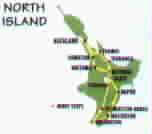
Mal & Tracy's travels 1995/6 New Zealand. 2/12/95 . . |
Saturday 2/12/95 - New Zealand
Bye bye Fiji. Hello New Zealand -
Land of the long white cloud.
Up at 06:00 to catch the 08:15 flight out of that tropical steamy heat and to the 'British summertime like' weather of Auckland, New Zealand.
By lunch-time we had ourselves a room at 'Auckland Central Backpackers'. It was a bit of a dive compared to our beach-front accommodation in Fiji but it served its purpose and had a travel centre where we planned our impending escape.
A tasty meal at a Korean restaurant round the corner and off to bed for an early rise.
Sunday 3/12/95 - Black Water Rafting.
On the 'Magic Travellers Network' bus at 09:00 heading south for Waitomo. The countryside is very much like England but the housing styles and layout are more like America.
If you look at the advertising, everything is Kiwi this and Kiwi that. These people have a fixation!
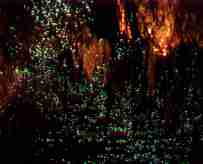 After a couple of
bus changes we end up in Waitomo and immediately arrange for a
trip to the local caves for the 'Black Water Rafting' trip. We
get picked up at 15:00 and are soon struggling into cold clammy
rubber suits. It becomes a temporary reprieve from the heat of
the day that soon turns into a 'silver foil on a chicken'
feeling. The worst is yet to come though as we then have to walk
up a steep path through a steamy jungle. At last we reach the
cool dark caves where the arduous feeling changes to an anxious
one as we float down a freezing underground river jammed into an
old truck inner tube. The ceiling drops close to the surface of
the water and we are forced to lie flat on our rubber rings to
get under. Here is where it turns into fun as we float down the
underground cave past rock formations and stalactites. When we
reach a waterfall we are asked to jump backwards off the top with
our bums jammed into our rings into the icy pool below. Later we
were asked to turn off our lamps and awed at the fantastic
display of glow worms attached to the ceiling. The display looked
like a green version of the stars in the night sky.
After a couple of
bus changes we end up in Waitomo and immediately arrange for a
trip to the local caves for the 'Black Water Rafting' trip. We
get picked up at 15:00 and are soon struggling into cold clammy
rubber suits. It becomes a temporary reprieve from the heat of
the day that soon turns into a 'silver foil on a chicken'
feeling. The worst is yet to come though as we then have to walk
up a steep path through a steamy jungle. At last we reach the
cool dark caves where the arduous feeling changes to an anxious
one as we float down a freezing underground river jammed into an
old truck inner tube. The ceiling drops close to the surface of
the water and we are forced to lie flat on our rubber rings to
get under. Here is where it turns into fun as we float down the
underground cave past rock formations and stalactites. When we
reach a waterfall we are asked to jump backwards off the top with
our bums jammed into our rings into the icy pool below. Later we
were asked to turn off our lamps and awed at the fantastic
display of glow worms attached to the ceiling. The display looked
like a green version of the stars in the night sky.
Soup and toast were supplied after our adventure to warm up our extremities that had been exposed to the freezing (12C) waters (OK so it seemed cold at the time).
Monday 4/12/95 - Rotten eggs.
A short walk through the jungle
like woods near town where the ferns grow on stalks looking
rather like a palm tree from a distance. The limestone rocks
looked like they had been sculpted for the Tate Gallery. These
woods were dense with either growing vegetation or last years
foliage now rotting on the ground or still hanging from the
trunk.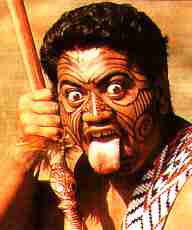
After the caving museum we had lunch at a Maori exhibition centre and walked back to the hostel to meet the bus.
By 18:00 we were in Rotorua - or 'Rotten-rua' as it is sometimes called by people who can't stand the smell of rotten eggs! (Hydrogen-sulphide).
This is the place where steam rises from the ground in a similar way to New York only here it is from natural causes. We passed a park which was steaming like a cooling tower. The steam comes from thermal activity around a volcanic fault line.
Once we had sorted out our accommodation we were whisked off to a Maori Hangi concert where the girls swung around little white balls on strings and the boys stuck their tongues out (a sign of defiance apparently).
We made use of the thermal spa at 'Spa Lodge' (NZ$13/night) and hit the sack.
Tuesday 5/12/95 - Splash, gurgle gurgle.
We turned down our places on the
bus today because they were not stopping long enough for us to go
rafting. At 11:00 we were off to Okere Falls on the Kaituna River
where 6 of us suited up and hopped into an inflatable  rubber
dinghy to paddle off down the fast flowing, clear green river.
The river meandered crazily between steep cliffs topped by trees,
virtually inaccessible accept by raft. Every so often the pilot
would shout paddling orders and we would round a bend and drop
down a waterfall into the foaming pool at the bottom. Fortunately
the waters were warm being heated by an occasional hot spring,
lucky it wasn't England eh!
rubber
dinghy to paddle off down the fast flowing, clear green river.
The river meandered crazily between steep cliffs topped by trees,
virtually inaccessible accept by raft. Every so often the pilot
would shout paddling orders and we would round a bend and drop
down a waterfall into the foaming pool at the bottom. Fortunately
the waters were warm being heated by an occasional hot spring,
lucky it wasn't England eh!
The waterfalls became gradually higher so that we had to jam our feet between parts of the inflatable raft and hang on to ropes just to stay in. Finally we came to the climax of our adventure, a 7 meter '5+' rated fall into a turbulent foaming pool at the bottom. After much psyching-up by our guides we plummeted over the brink into the roaring waters and pounded into the pool at the bottom with the raft bucking and bending as it was hammered by the force of the water and the weight of the people in it.
It was all over far to soon and after a couple more rapids we were back on shore.
The afternoon was spent sedately walking round the Whakarewarewa Thermal Reserve where mud pools bubble and plop, water boils in puddles all on its own and geysers spout as only geysers do.
The evening was for relaxing back in the smelly sulphur spa with a bottle of beer.
Wednesday 6/12/95 - Plummet....
Out of smelly city and off to Lady
Knox Geyser where a man primes the hole with soap to set the
geyser off at about 10:15 every day. 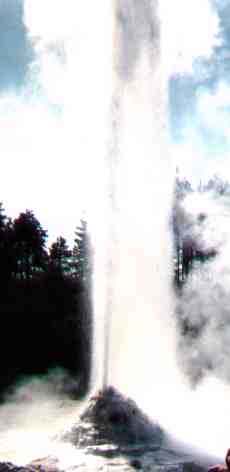 Seems a bit of a
swiz but apparently that was how it was discovered when a group
of workers tried to wash their cloths in the hot water. The
resulting gush of boiling water can reach heights of up to 21
meters. A number of spectators nearly got boiled.
Seems a bit of a
swiz but apparently that was how it was discovered when a group
of workers tried to wash their cloths in the hot water. The
resulting gush of boiling water can reach heights of up to 21
meters. A number of spectators nearly got boiled.
Down in Taupo Tracy convinced me to do a tandem sky-dive with her, well, not with her but at the same time; the second half of the tandem was called a 'Tandem Master', I guess that would make us 'Tandem Slaves'. The cost was NZD165 and it took all of 20 minutes to fly up to 9000ft and 5 minutes to get down again including 30 seconds of free fall.
I sat on the floor next to the transparent plastic door of the small 2 engine plane. There were 4 paying nutters, 4 tandem masters, a surf boarder and a man with a video camera stuck to his head. As we gained altitude I could look out at the view of the very large Taupo lake, commercial forests, towns, roads and the magnificent peaks of the still active volcano capped by clouds (of the ordinary water variety). Occasionally thoughts crossed my mind like, 'what if the door slipped open and I fell out without my Tandem Master ?'
All to soon we were at 9000ft and I ensured that I was clipped onto my 'Master' and more importantly the parachute before the door was opened.
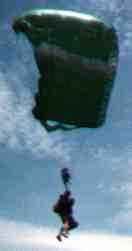 'Surf board man'
and 'camera head' went out first in a matter of seconds but I did
not see what happened to them as I was to concerned about myself.
Having my Master strapped to my back meant that I went where he
went, just first. I remember a brief moment of fear and panic as
my brain told me that I was just the wrong side of mad before I
was flung head-first out into the blue yonder to plummet,
tumbling head over heels to earth.
'Surf board man'
and 'camera head' went out first in a matter of seconds but I did
not see what happened to them as I was to concerned about myself.
Having my Master strapped to my back meant that I went where he
went, just first. I remember a brief moment of fear and panic as
my brain told me that I was just the wrong side of mad before I
was flung head-first out into the blue yonder to plummet,
tumbling head over heels to earth.
We only tumbled once before the banana pose brought us face down for the rest of the free fall. All the feelings of fear drained away when we started the free-fall and the panoramic view came into focus. 30 seconds seemed to take forever as the wind rushed past at 200km/h but at this height the ground did not seem to come perceptibly closer. When the chute opened we were lurched quickly to a much slower descent and it was now that I appreciated getting the harness straps in the right place. I had a go at pulling the control strings and we did a few pirouettes before landing next to the 'Lake Taupo Tandem Skydiving' office.
Back on the 'Magic' bus we set off for Turangi where we were to spend the night. From there we went for a walk up the outside of an extinct volcano to swim in Lake Rotopoumanu (Hidden Lake) before a barbecue back at 'Club Habitat Backpackers'.
The 'bush' out here is magnificent, where the plant life really takes over and walking off the beaten track is virtually impossible without an axe or a 'dozer. The roads are few and far enough between for there to be no sound of cars to disrupt the bird-song and rustle of wind in the treetops. To top it off the sun was warming but not overpowering.
Thursday 7/12/95 - Volcano
Rush hour in Turangi is just about the same as the rest of NZ, quiet. With a population of just 3 million it's supprising anyone ever meets. We certainly don't see much traffic on the roads we travel on. In the town centres of an evening you are lucky to see two cars moving at the same time.
 Out of town we
pass two volcanoes, one active and still belching smoke from a
recent eruption and the other dormant but sporting the classic
cinder cone shape, resting on a bed of green bushes, streaked
with black ash and snow, and shrouded by deep blue sky dotted
with white puffy clouds.
Out of town we
pass two volcanoes, one active and still belching smoke from a
recent eruption and the other dormant but sporting the classic
cinder cone shape, resting on a bed of green bushes, streaked
with black ash and snow, and shrouded by deep blue sky dotted
with white puffy clouds.
The active volcano had spread a liberal dose of ash over the surrounding countryside, closing the road a couple of times. The ragged cinder cone was streaked and dappled with black, browns, reds and greys giving it an alien appearance especially with the morning sun creating shadows on the rocky surface. !WOW!
Along the way there is evidence of deforestation with sheep grazing on fields littered with dead trees and tree stumps. Although NZ is reputed to be planting more trees than it is harvesting (let's hope it's true and that other countries follow suit).
Sadly there are even acres of finely manicured grass fields saturated in fertiliser enough to poison the surrounding waterways and drain the local water tables to keep watered in their unnatural state. These areas are mainly unoccupied and unused except for one or two people with sticks and little white balls looking more stupid than the sheep. What a shameful waste!
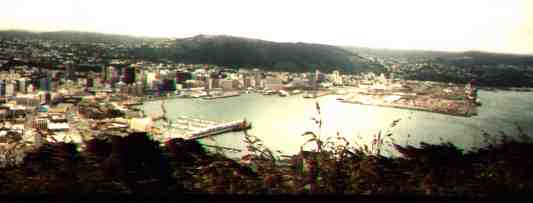
On and on we went all the way to windy Wellington, and they don't call it that for nothing. We stayed at the Downtown Backpackers (NZ$15 each) which used to be the Waterloo Hotel, the best in Wellington in it's time - fit for royalty. Now it's just a rather posh backpackers hostel.
Legend has it there is not much to see in Wellington - the capital city - but we went out to see anyway. Sure enough we did not see anything spectacular but we did eat a nice Thai meal for $4 each.
Friday 8/12/95 - To the south island, Nelson and the centre of NZ.
 Up early and off to the 09:37 sailing of
the ferry out of windy, overcast
Up early and off to the 09:37 sailing of
the ferry out of windy, overcast 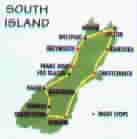 Wellington. After
a 3 hour crossing we reach the Marlborough Sounds at the north
end of the south islands. The ferry weaves its way around the
large, tall, conical shaped, tree covered islands that make up
the sounds. The water is a wonderful light blue/green colour
edged by yellow beaches. Occasionally you can see a house nestled
into the trees at the shoreline with no visible means of access
except by sea - exclusive or what!
Wellington. After
a 3 hour crossing we reach the Marlborough Sounds at the north
end of the south islands. The ferry weaves its way around the
large, tall, conical shaped, tree covered islands that make up
the sounds. The water is a wonderful light blue/green colour
edged by yellow beaches. Occasionally you can see a house nestled
into the trees at the shoreline with no visible means of access
except by sea - exclusive or what!
This is the first part of New Zealand landscape where you cannot imagine that you are in the UK. Hours of travelling on the bus through bush covered hills where no part of the landscape is closer than 30 degrees from the horizontal. It's a bit like the Peak District but peakier. Many of the hills are covered by commercial pine forests but some farmland has been allowed to return to what they call 'second generation bush'.
At Nelson we check into 'Daves Palace' (NZ$15 each). Dave is described as a bit eccentric but when we meet him he just seems gloomy and bored.
Nelson is situated at what is described as the centre of New Zealand. The main part of the small city (it has a cathedral!) lies on the flood plain of a river with residential areas spreading up the surrounding hills. The Magic bus driver said that this was the place where most NZers would like to live and it is easy to see why. It has more hours of sunshine than any other settlement in NZ and has a very pleasant atmosphere.
We walked up an inland hill to get a better view of the place. It looked like a huge amphi-theatre with the sea as the stage (there was no performance on whilst we were there).
Back in town we ate at an Egyptian cafe, just for kicks.
Sat 9/12/95 - Sea and seals.
Hours of driving today through the
same scenery as yesterday. Tall hills like mini-mountains, deep
valleys, gorges and lots of trees. The dead trees have apparently
been killed by the incessant munching by possums. These little
rodents were introduced into NZ for fur and meat but without
natural predators they have multiplied to an estimated 80 million
across the country. The drivers favourite trick is to try and
squash as many as possible.
A quick stop to watch the 'surfies' surf in the Tasman sea by the estuary of the river Buller which we followed from near its source all the way down.
12km down the coast we went to spot a breeding colony of grey/brown Fur Seals against a backdrop of grey/brown rocks splashed by the turbulent seas.
We were fortunate to arrive during the late November, early December breeding season when the colony are on shore with their young. The colony numbers have risen to between 200 and 660 depending upon time of year.
We travelled on in sunshine but 'the long white cloud' covered the mountains just inland.
Further on down we stop again to see the 'pancake rocks', layered limestone rocks worn by the sea to look like stacks of pancakes. On the seaward slope of the hill purple and white mountain lupines decorate the narrow strip of green fields. African Water Buffalo(!?) graze in one of the fields, the result of an NZ entrepreneurial farmer.
Sun 10/12/95 - Gold rush & cold encounter.
Off down the coast to the old gold mining town Hokitika where the streets were really paved with gold and miners used to pick nuggets out of the cracks in their shoes after walking across the main street, or so it is said. Jade, or greenstone, also big here and is worked into all the usual Maori shapes.
Next we stopped off at the Mahinapua Hotel which serves the strongest beer in NZ, all of 6% !. We opted for the hot scones with jam and cream as most of the NZ beer is pretty much tasteless.
The hotel like many of the buildings in small towns or settlements have a temporary feel about them, being built of wood and corrugated steel.
We visited the small gold mining settlement of Ross which still supports a couple of mines but I think most of the easy money is now made from charging tourists $5 to sift one pan of rocks. Many of our party had a go and all managed to collect a handful of gold nuggets the size of flattened grains of sand, chunks of jade the size of grains of rice and the odd garnet. No one exactly made their fortune.
 Higher into the
hills we rounded a bend in the road and saw a streak of white
filling a valley between two mountains looking a bit like a
synthetic ski slope. This turned out to be the Franz Josef
Glacier. As we walked closer the sight became more and more
unbelievable. The glacier stretched for about 5km down the valley
from the source in the snow capped mountains to the craggy, light
blue 'foot' in the valley in front of us. Other small glaciers
fed into the ice pool at the source and also the top of the
glacier, helping to push it on its inexorable way down the
valley. Streams poured as waterfalls onto the glacier after it
had severed their channels before receding back up its 'U' shaped
valley. This glacier was something else. Advancing at about 50cm
per day at this time of year it was flowing down the valley
cutting it's path deeper into the rock and cracking into huge
shards as it tried to fold over resistant boulders. The ice,
although clear, had a light blue appearance for the same reason
that the sky looks blue. When we got up close we found that the
surface was cracked like a broken car windscreen but had been
weathered into dimples on the surface. Streams of ice melt had
cut channels into the surface and sink holes through to the core.
Higher into the
hills we rounded a bend in the road and saw a streak of white
filling a valley between two mountains looking a bit like a
synthetic ski slope. This turned out to be the Franz Josef
Glacier. As we walked closer the sight became more and more
unbelievable. The glacier stretched for about 5km down the valley
from the source in the snow capped mountains to the craggy, light
blue 'foot' in the valley in front of us. Other small glaciers
fed into the ice pool at the source and also the top of the
glacier, helping to push it on its inexorable way down the
valley. Streams poured as waterfalls onto the glacier after it
had severed their channels before receding back up its 'U' shaped
valley. This glacier was something else. Advancing at about 50cm
per day at this time of year it was flowing down the valley
cutting it's path deeper into the rock and cracking into huge
shards as it tried to fold over resistant boulders. The ice,
although clear, had a light blue appearance for the same reason
that the sky looks blue. When we got up close we found that the
surface was cracked like a broken car windscreen but had been
weathered into dimples on the surface. Streams of ice melt had
cut channels into the surface and sink holes through to the core.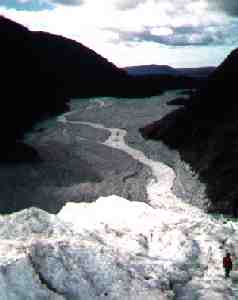 The warm air and rain had melted the leading edge
sufficiently to create a torrent of water that splashed and
meandered excitedly down the valley. Despite this the glacier was
still advancing.
The warm air and rain had melted the leading edge
sufficiently to create a torrent of water that splashed and
meandered excitedly down the valley. Despite this the glacier was
still advancing.
We were all kited out with hob-nail boots, woollies, waterproof jackets and ?shorts? (apparently jeans get wet and even colder than bare legs, hard to believe when you are freezing on top of a huge ice cube).
Our guide cut steps into the ice and we all climbed slowly to almost the top of the leading edge a couple of hundred meters up. We stepped over deep crevasses where the ice had broken as it flowed over humps in the ground and stepped gingerly around sink holes into which you might disappear forever. The ice-scape was sometimes smooth and rolling, other times jagged with deep narrow cracks that disappeared down out of sight and sharp blades slicing into the grey clouded sky.
Even when we were standing on top of the thing it was still hard to believe that it was really there, stabbing through the rain forest only a few kms from the Tasman sea.
It was kind of disappointing that we were not there during a rain storm as the warm rain seeps through the glacier opening up cracks and pouring through the under-ice tunnels in torrents until it rips out the mouth of the tunnel showering huge chunks of ice down the valley and changing the course of the river every few minutes - dramatic eh!
Monday 11/12/95 - Rain-forest and rain.
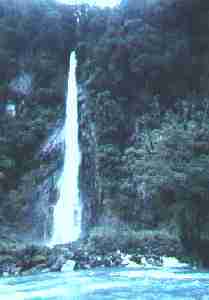 We took a walk
through the dense rain-forest where moss grew on all the trees
making them look fury or fluffy and without the nice civilised
wooden walkway we would never have passed, the long awaited and
promised rains came and continued for the rest of the day. This
put a new complexion on the countryside and brought out the
colours in the vegetation, most of which we do not have in
England.
We took a walk
through the dense rain-forest where moss grew on all the trees
making them look fury or fluffy and without the nice civilised
wooden walkway we would never have passed, the long awaited and
promised rains came and continued for the rest of the day. This
put a new complexion on the countryside and brought out the
colours in the vegetation, most of which we do not have in
England.
A quick stop at a salmon farm secured our grub for the barby that night.
Much of the landscape now consists of snow capped mountains poking up above the tree-topped hills into the grey clouds above. Silver streaks mark the passage of a river running rapidly downhill. Thin clouds separate the hills into graded grey scales to mark their distance away. Clear blue rivers run their shallow course over pebbled flood plains surrounded by green green grass.
Next we headed east along the Hasst river and over the Hasst Pass heading up and up into the cloud shrouded mountains stopping at Thunder Creek Falls.
That night we had a barby in the rain and cooked our salmon. Fortunately the barby was sheltered and there was a hall with a log stove burning in the corner.
Tuesday 12/12/95 - Puzzled ?
With it still raining we headed of into the hills and visit the Puzzle Centre and Maze at Wanaka. The maze was good and puzzling an took us about 45 minutes to complete (in the rain).
The rain abated as we headed over the treeless hills. Apparently the Morioris had burnt down all the Forrest 1000 years ago in pursuit of the huge flightless Moa bird until it became extinct. Now the Morioris are thought to be extinct and have been replaced by the Maoris who also migrated from Polynesia but only about 600 years ago. Now the land is used by the European settlers for farming and vineyards.
On to Kawarau to watch loads of lemming like people falling off a bridge with only an elastic band to save them from a watery grave. People were falling off about every 3 minutes but at NZ$135 it was a bit of an expensive thrill or a money-spinner depending on which side of the till you were. Most people were wet before they hit the river as it was still raining.
Wed 13/12/95 - Rain, rain and more rain.
Today is our free day in Queenstown, arranged because there is so much to do here. Unfortunately, after raining all night it also rained all day until about 16:30. We ended up using the day as a rest day and stayed in bed till 10:30. The level of the lake rose as did the flood waters in the streets. From the comfort of McFees backpackers kitchen/lounge ($45/night) we watched the hoteliers across the street build barricades with sand bags.
Thursday 14/12/95 - Natural disaster.
During the night the level of the
lake had risen and flooded the road 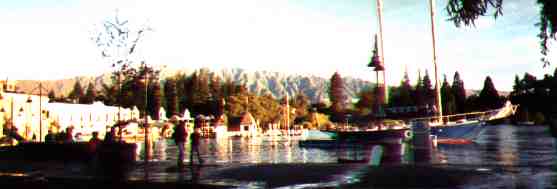 and park by the
edge. One of the rivers that drains the lake had risen by 18
meters, just 2 meters below the suspension bridge that carries
the road. Many houses were flooded out in the local town of
Alexandrea.
and park by the
edge. One of the rivers that drains the lake had risen by 18
meters, just 2 meters below the suspension bridge that carries
the road. Many houses were flooded out in the local town of
Alexandrea.
In the morning the skies were clear and the mountains were visible in all directions. There was a different sight in each direction; the rounded light green hills covered in grass and low shrubs, dark green of pine trees with a cable car path cut through them, dark grey craggy rocks with snow caps. Unfortunately it was too late as we were off to Dunedin.
We encountered our first traffic jam in NZ. On the road from Queenstown to Alexandrea the heavy rains of the past few days had caused a land-slip across the road only minutes before we arrived. We waited for an hour or so but as soon as the rocks were cleared more tumbled down so we turned around and took another route. It was our third trip along this road but the many shades and colours of mountain lupines, wild rose bushes covered in little pink blossoms and other assorted wild flowers glowing in the midday sunshine made up for it.
Friday 15/12/95 - Family presence.
We started by visiting the Athenaeum Library on the octagon at the centre of Dunedin. Inside was deserted except for a little old lady who knew exactly the book we were looking for an led us straight to it. When she found out that I was a direct relative of the Weller brothers and would like to obtain a copy of the book she was very helpful and gave us a list of places to try.
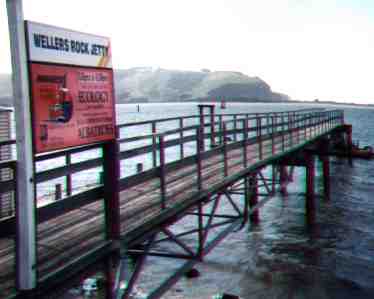 Our next stop was
the Otago Daily Times who's offices were located just down the
next street and had sponsored the books. Unfortunately they did
not know of the book but guesses the publisher must be Otago
Heritage Books and gave them a ring. We were in luck, the book
was still in print and they had a copy for $24.50.
Our next stop was
the Otago Daily Times who's offices were located just down the
next street and had sponsored the books. Unfortunately they did
not know of the book but guesses the publisher must be Otago
Heritage Books and gave them a ring. We were in luck, the book
was still in print and they had a copy for $24.50.
Before going we walked across the road to the second place suggested by the library lady. This little second hand book shop had a copy of the book for $45 so naturally we decided to travel out to Otago Heritage Books. Before we got anywhere we were side-tracked into the information centre and booked ourselves onto a tour round the Otago Peninsula. The people in the
At the end of the peninsula we
visited colonies of breeding Albatross' and Yellow Eyed Penguins.
Along the way we also saw Fur Seals lounging on the beach and a
Blue Penguin hiding in a hole under some rocks. We were fortunate
in seeing quite a few Albatross' soaring in the ridge-lift
created when the sea breeze hits the steep cliffs of Taiaroa
Head. They hardly ever flap their huge 3 meter wing span as they
would soon tire if they had to but just use the air currents to
stay airborne. On land they are not quite so graceful.
At the penguin colony we had to walk down trenches to secretly reach the hides. Some of the penguins had young grey fluffy chicks that each looked like Winston Churchill. The hides allowed us to come within 4 or 5 meters of the nest site. Strangely enough the penguins chose the man-made nests that were built to house them even when the bush had been regrown for them.
information centre and the tour guide all knew about the Weller brothers, Weller rock and all the history of the early whalers and settlers and were excited to hear that I was descended from the same family tree. We received lots of help and ended up taking the tour in two parts so that we could spend some time at Weller Rock.
Saturday 16/12/95 - Wellers and whales.
First off we visited the 'Otago Heritage Books' shop to pick up a copy of 'Advance Guard Series 3' which contained an essay about the Weller Brothers who landed at Weller Rock in Otakou and started a whaling station in 1831. Whilst we were there the store keeper showed us another book with more information which we also purchased.
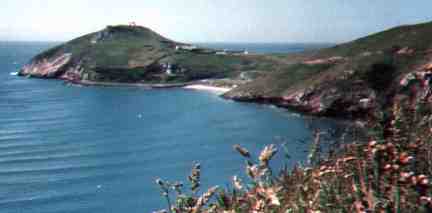 Across the road
we found the Hocken Library in the University of Dunedin which
contained portraits, scenic drawings and photographs of the
Weller brothers, their whaling station and the Maoris who lived
at Otakou. Unfortunately we were not able to view all of the
drawings as some were locked in archive and inaccessible during
the weekend. We only managed to see the drawings after the curate
found out that I was a descendant of the Weller Brothers.
Across the road
we found the Hocken Library in the University of Dunedin which
contained portraits, scenic drawings and photographs of the
Weller brothers, their whaling station and the Maoris who lived
at Otakou. Unfortunately we were not able to view all of the
drawings as some were locked in archive and inaccessible during
the weekend. We only managed to see the drawings after the curate
found out that I was a descendant of the Weller Brothers.
Next stop was the 'Otago Early Settlers Museum' now renamed 'Otago Settlers Museum'. Here we found that the Weller Brothers and their whaling activities and associations with the Maoris were featured with documentation and pictures.
After a hard day at the museum we managed to soak for a while in our first bath for almost 2 months.
Later we went out to a 'blues Bar' which, instead of having a blues band playing on Saturday night, was just coloured blue! The locals were friendly though' so we stopped, chatted, sampled the local beer and played pool.
Sun 17/12/95 - Rotten eggs.
Today started slowly with the bus breaking down before it even reached our hostel. Two hours later at ten o'clock when the cooling fan had been replaced, we set off north for Moeraki Boulders. These were a collection of almost spherical boulders about 2 meters across, scattered around the beach. They were made of calcite crystal veins filled in with a dark sandstone like rock. Some had been subject to the sea weathering for so long that they had cracked along the veins and the rock had broken open on the beach. Huge bull kelp seaweed had washed on top of one looking like an alien crawling from a broken egg. The other boulders clustered round took on the appearance of a clutch of eggs (spooky).
The rains were back with us again and another 100mm were expected in the Otago region.
Christchurch turned out to be an OK sort of place for a city. We took a stroll through the Botanical Gardens and into the centre which was specially quiet as it was Sunday evening. We found probably the only Indian restaurant in the whole city for dinner.
Monday 18/12/95 - Last day.
We had just enough time to visit the Botanical Gardens again (cos it was good) before we jumped on the shuttle bus to the airport.
All over NZ we found that many of the transport services would run a free or cheap shuttle bus to collect you. This included airports, train and bus stations. This one was $6 each and picked us up from our hostel. Many of the more expensive activities such as White Water Rafting and Sky Diving would pick you up from your hostel and drop you off even to the next stop of your Tour Bus.
We left time to visit the Antarctica Centre next to the airport before our plane left.
The Kiwis and the Aussies seem to be acutely aware of the environment and the effects that human overpopulation and development have on it. Everywhere we looked there were stories of wildlife that were dying out because of pollution, overdose of Ultra-Violet radiation, the effects of global warming or loss of habitat.
Even these threats don't seem to stop people from wasting what they have, taking more than they need and evicting animals and cultures from an area for their own selfish purposes.
It is admirable to see how the Fijian, Maori and Aboriginal people managed to live within the environment rather than engulfing it.
OK, enough of the preaching.
What would I have done in NZ if I had got to do it all over ?
Well, I would still take the Magic Bus tour as it was the cheapest and easiest way to get around but I would take 3 to 4 weeks over it instead of just 16 days. The way we had it was too much travelling on a boring bus and not enough play and relaxation. There were many places we would have stopped for a few days if we had the time.
| Travelogues by Malcolm Weller |  |